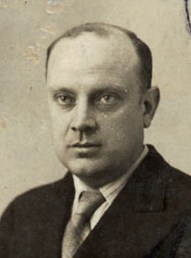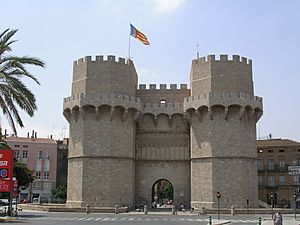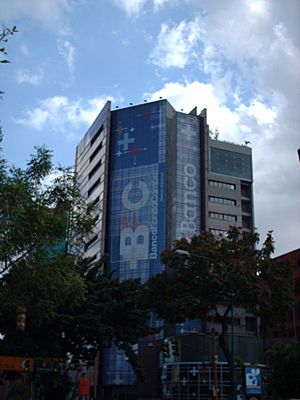José Lino Vaamonde facts for kids
Quick facts for kids
José Lino Vaamonde Valencia
|
|
|---|---|

José Lino Vaamonde from his identity card for the 1937 Paris Exposition
|
|
| Born | 20 April 1900 Alongos, Orense, Spain
|
| Died | 3 October 1986 (aged 86) Caracas, Venezuela
|
| Nationality | Spanish |
| Occupation | Architect |
José Lino Vaamonde Valencia (born April 20, 1900 – died October 3, 1986) was a Spanish architect. He was very important in saving Spain's valuable artworks during the Spanish Civil War (1936–1939). After the war, he moved to Venezuela. There, he became a top architect for the Shell company. He designed many buildings, like gas stations, oil worker communities, schools, and offices.
Contents
Early Life and Career (1900–1936)
José Lino Vaamonde Valencia was born in Alongos, Orense, Spain. This was on April 20, 1900. He grew up in a wealthy family with seven brothers.
He studied Exact Sciences and Architecture in Madrid. He became a qualified architect in 1928. Besides his architecture work, he was also the secretary of the famous Real Madrid football club.
Vaamonde helped build parts of the Madrid Metro system. He also worked on the railway connecting Ourense and Santiago. In 1934, he married Flora Horcada. Their son, Joselino, was born in 1937.
Saving Art During the Spanish Civil War (1936–1939)
In 1936, Vaamonde became the architect in charge of preserving the Museo del Prado. This is a very famous art museum in Spain. In 1937, he joined a special board to protect artistic treasures.
When the war started, bombs fell on the museum. Vaamonde quickly made detailed plans and took photos of the damage. These were later shared internationally to show the world what was happening.

The government decided to move valuable artworks from the Prado Museum to Valencia for safety. Vaamonde helped move these masterpieces. He was in charge of keeping the art safe in Valencia. He turned old buildings, like the Torres de Serranos and the Church of the Colegio del Patriarca, into safe storage places for the art.
In 1937, people from other countries visited Valencia. They were very impressed with Vaamonde's work. They wrote a positive article about it in The Times newspaper.
Vaamonde also helped design bomb shelters in Madrid. He worked for the Spanish Pavilion at a big international exhibition in Paris in 1937. Later, he helped with aid efforts for Republican Spain in Paris.
Life and Work in Venezuela (1939–1986)
After the Spanish Civil War ended in 1939, Vaamonde left Spain. He lived briefly in Paris and Havana before moving to Venezuela.
In Venezuela, he first worked in business in Valencia. In 1942, the Spanish government prevented him from working as an architect in Spain for many years. Around 1945, Vaamonde moved to Caracas.
In 1946, Vaamonde started working for Shell Venezuela. He became a very important architect for the company. He helped organize Shell's architectural services. He designed homes, hospitals, clubs, and schools for the company's workers.
He also designed entire communities for oil workers, called oil camps. Examples include Lagunillas (1954) and Altagracia (1958). These were self-contained towns where workers lived.
In the 1950s, Vaamonde's team began designing gas stations. These were the most visible parts of Shell's business to the public. He oversaw the building of the first Shell service stations in Caracas.
Vaamonde became a Venezuelan citizen in 1952. He presented his work for Shell at architecture conferences in Mexico City and Caracas.
He designed many other buildings for Shell. These included training centers, clubs, and parts of hospitals. He also designed schools like Colegio Claret (1957) in Caracas and Colegio San Francisco Javier (1959) in Punto Fijo. His last big project before retiring was the new Shell headquarters in Caracas (1957–60). This building had a simple, modern design.
In 1973, Vaamonde published a book about his work saving Spanish art during the war. He also wrote an article on the same topic in 1976. José Lino Vaamonde died in Caracas, Venezuela, on October 3, 1986.
Images for kids
See also
 In Spanish: José Lino Vaamonde para niños
In Spanish: José Lino Vaamonde para niños





